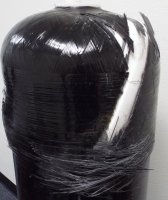You don't say what the static water level is in the well or what the dynamic water level is.
The water level is what is important, but for maximum vacuum, the drop only has to be enough to correspond to the atmospheric pressure. The highest atmospheric pressure ever recorded on earth is 32.06 inches of mercury, which is 36.32 feet of water. Any depth to water greater than that cannot make a stronger vacuum. A vacuum cannot go below zero psi. Water at 50 or 60F water boils at about 1/4 PSI absolute, but that is still way more vacuum than it takes to make the tanks fail.
Fiberglass media tanks, as far as I can tell, are typically rated to 5 inches of mercury vacuum (2.46 psi). That is only 5.66 feet of water. I am confident there is some margin in the spec, but it would seem that even a shallow well system could in theory have the problem.
A broken check/foot valve leaking water back into the well will decrease the water pressure to the cut in setting of the pressure switch controlling the pump and thereby turn the pump on.
Yes. The problem scenario only occurs if the pump does not run for some reason, for example power fail or broken pressure switch.
Here is another scenario that does not require the check valve to fail: What if the drop pipe fails? Pump stops for whatever reason, and there is an underwater hole in the drop pipe?
I don't currently plan to add a vacuum breaker. I figure the chance of this occurring is not high, and the failure of my water heater, iron filter and softener in the basement is not catastrophic. I wonder if that would be covered by homeowner's insurance.
Hmmm. Score one for the conventional pressure tank with snifter valve. That valve would seem to work as the vacuum relief. I wonder about using a snifter valve with a diaphragm pressure tank. Would its air path be big enough, I wonder?



